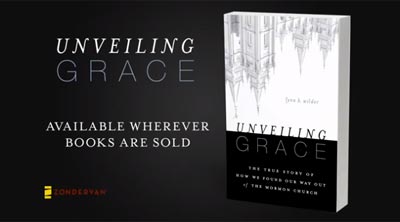

There are many things I disagree with in Lynn Wilder’s ex-Mormon memoir, but compared to others in this genre it is fair and informative.
If you’ve read a fair number of ex-Mormon narratives (or ex-Catholic, or ex-Hobbit, or ex-anything), you’ll know that they tend to follow a familiar pattern. The memoirist:
- Gets sucked into the religion (or delves deeper into it, if she grew up in that tradition)
- Enjoys a (usually brief) honeymoon period with it
- Becomes disillusioned upon learning truths about the faith that no one had thought to reveal before
- Decides to leave
- Encounters resistance from others about her leaving, and
- Discovers truth, joy, and unicorns outside the evil cult that had robbed her of her best years.
Although Lynn Wilder’s Unveiling Grace follows the same basic trajectory of other memoirs in its genre, I found it a cut above, and I hope active Mormons will give the book a fair hearing.
However, it has a lot of obstacles to overcome if it is going to be taken seriously by Latter-day Saints.
First off, its title will raise the eyebrows of any Mormon who studies history and knows that the world’s first-ever anti-Mormon book, the 1834 muckraker Mormonism Unvailed [sic], bore a similar title, and that that book was full of errors and outright lies.
Second, the front cover’s depiction of an inverted Salt Lake City temple will raise Mormon hackles, as it suggests that everything about the religion is wrong, doomed, and dangerous. The temple looks to be crashing down in a sinister way.
And third, the book description glitters with incendiary language about “controversial church practices” and how the family barely escaped Mormonism’s clutches, etc. The press release opens with the sentence:
More than ever, Mormonism is gaining a foothold in mainstream culture, drawing hundreds of thousands of new followers each year and employing an aggressive public relations campaign to convince even prominent U.S. Christians that Mormonism is a Christian faith, too.
Danger, Will Robinson Protestant!
Sigh.
So I was pleasantly surprised to find the book itself was more even-handed than its packaging would suggest. Wilder, who converted to the LDS Church with her husband in the late 1970s, served in many capacities in the Church, including as a temple ordinance worker and stake Relief Society president. She also taught in the BYU education department for years. She knows Mormonism.
And yet the book is not a traditional go-for-the-jugular exposé. The temple section, for example, is even a little vague when compared to memoirs written by the likes of Deborah Laake twenty years ago. Wilder certainly sees her journey out of Mormonism as one from error into light—she now considers Mormonism a “works-based faith” that removed her from “the bigger God” of the evangelical tradition she now embraces—but she is civil to the religion she left behind. She recounts many beautiful spiritual experiences she had while a Mormon, including an electric sensation at her patriarchal blessing and the joy of raising her children in a religion that so heavily emphasized family love.
Speaking of love, I am always skeptical when non-Mormons who write books about Mormonism’s flaws say they do so because they “love” the Mormon people. I’m rarely feeling the love, to be honest. But with this memoir, I could at least glimpse it at times, and believe that Wilder’s heart is in the right place. So I hope Mormons will evaluate the book based on its own merits without shooting the messenger or dismissing it sight unseen or any of the other knee-jerk reactions that we have adopted because—let’s face it—we have been burned far too many times.
I certainly don’t agree with many of Wilder’s critical assessments of Mormon theology. She is persuaded that the biblical God, the God of grace, is not to be found in my religion; as you can see from this spirited blog discussion several months ago, any depiction of evangelicalism as a champion of grace and Mormonism as a defender of works is grossly oversimplified. Also, some of her explanations of Mormonism border on caricature, e.g., “the fruit of Mormonism is to create gods (polytheism), spawn converts to a false gospel (even drawing people away from biblical Christianity), and save those who are already dead . . . this last one is creepy.” I am not a polytheist, unless you count the fact that I worship Joss Whedon as well as Jesus Christ, and I don’t quite recognize the religion Wilder is talking about here.
But overall, the memoir is a fair account of one family’s spiritual journey in and out of Mormonism. Although the basic tenets of Mormon theology are unlikely to change from outside criticism, the Church would do well to take heed of some of the other things that began creating cognitive dissonance for Wilder and her husband. He, for example, was distressed to learn after nearly three decades as a Mormon that some leaders of the Church continued to practice polygamy—and lie about it to government officials—after the 1890 Manifesto supposedly put an end to the practice. Learning the historical truth about polygamy was one of the death knells to his belief in Mormonism, and perhaps it would not have been if the Church had been more honest about its past. All religions have skeletons in the closet, and it is ultimately far more damaging than beneficial to pretend they aren’t there.
More than anything, I hope the book can spark some candid discussions, both between evangelicals and Mormons and among Mormons themselves.
